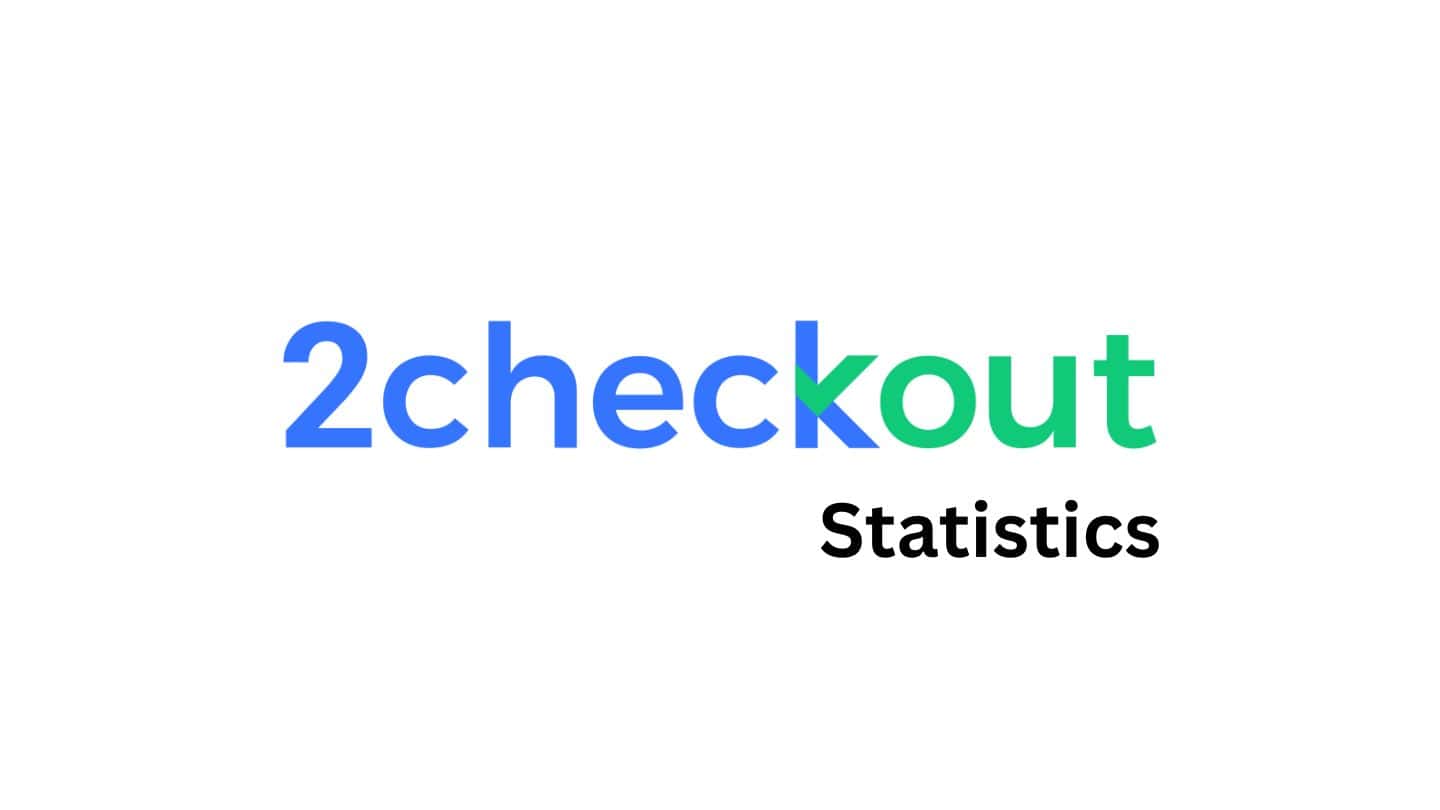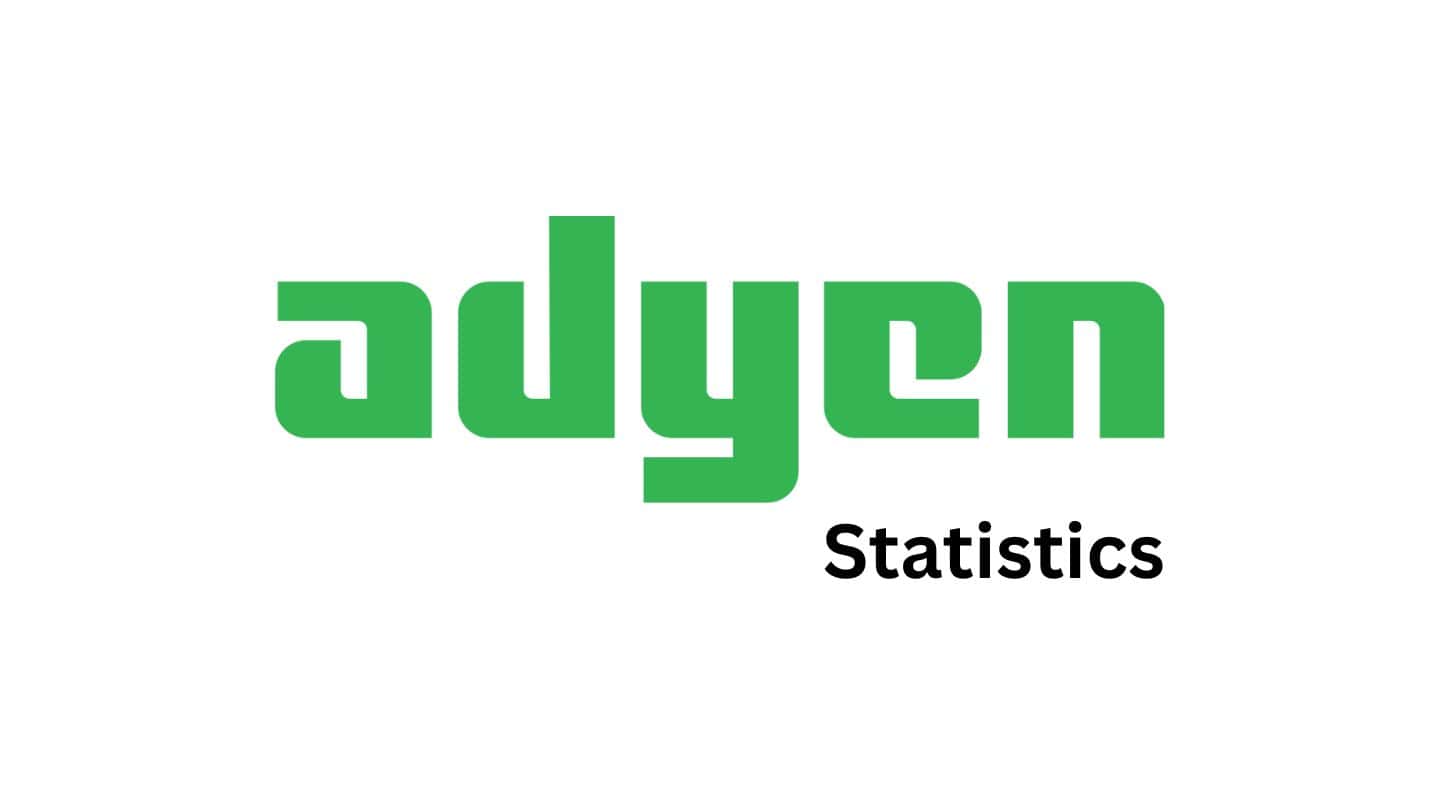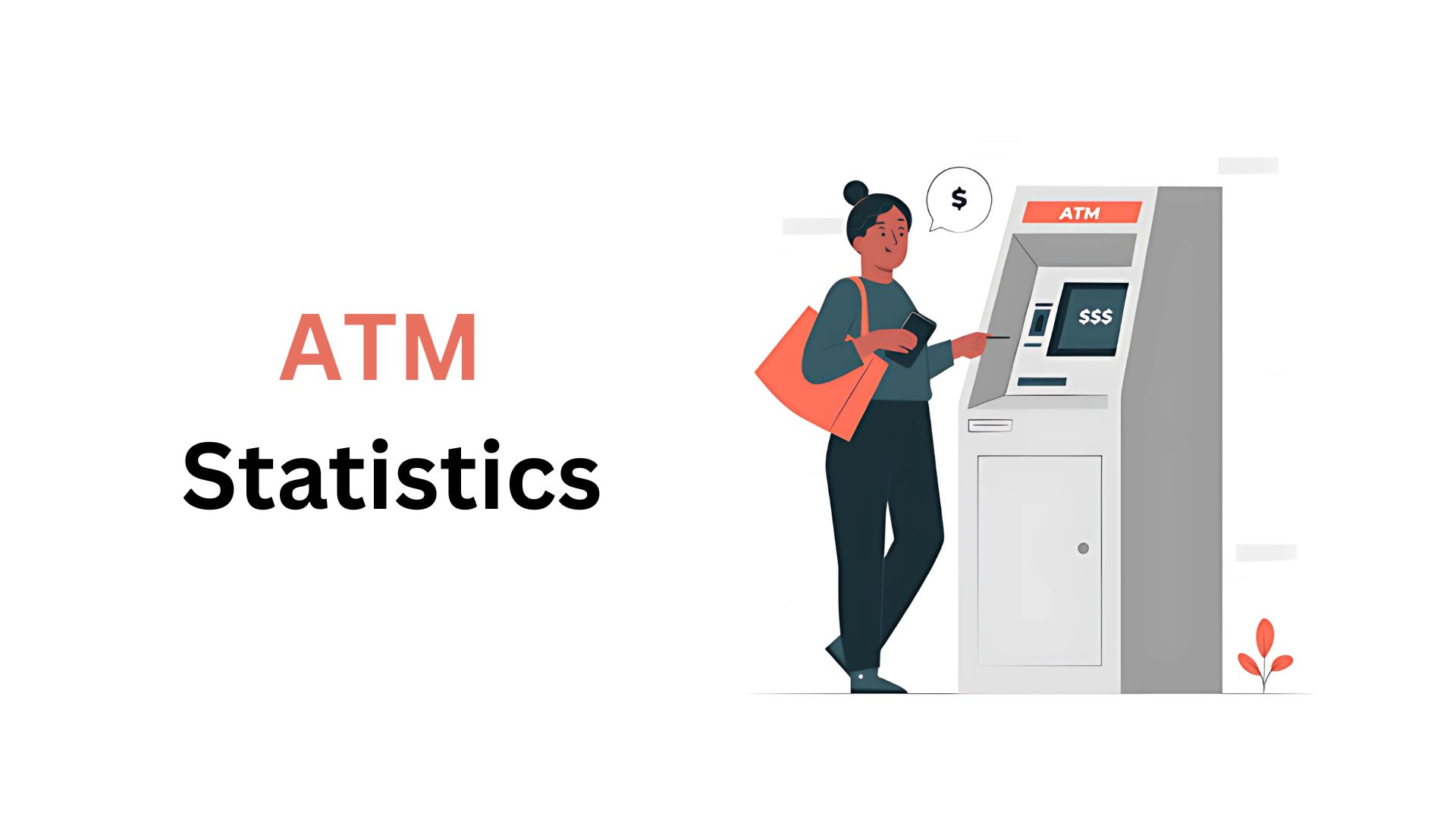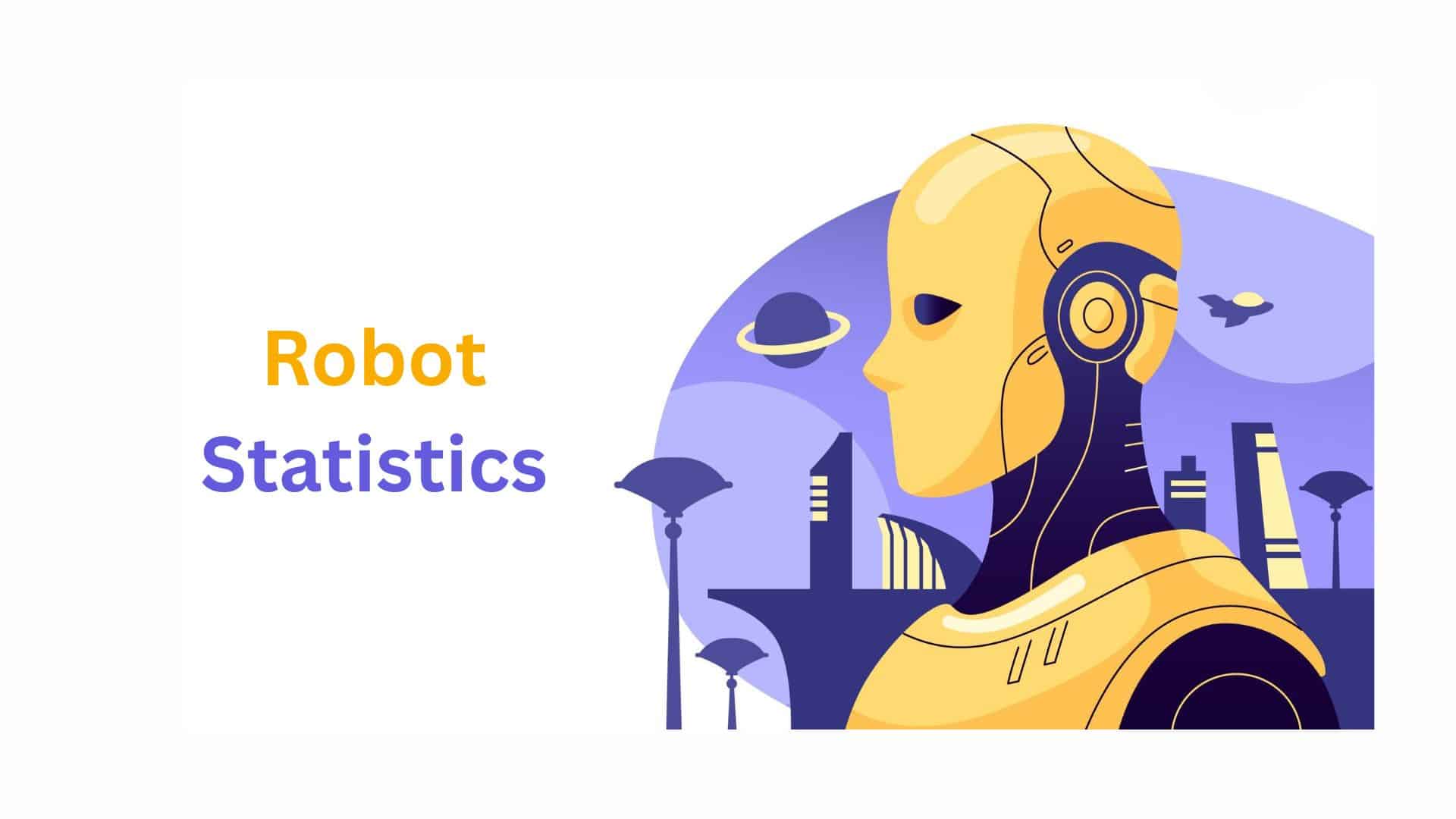European Space Agency Statistics By Revenue and Facts (2025)

Updated · Dec 03, 2025

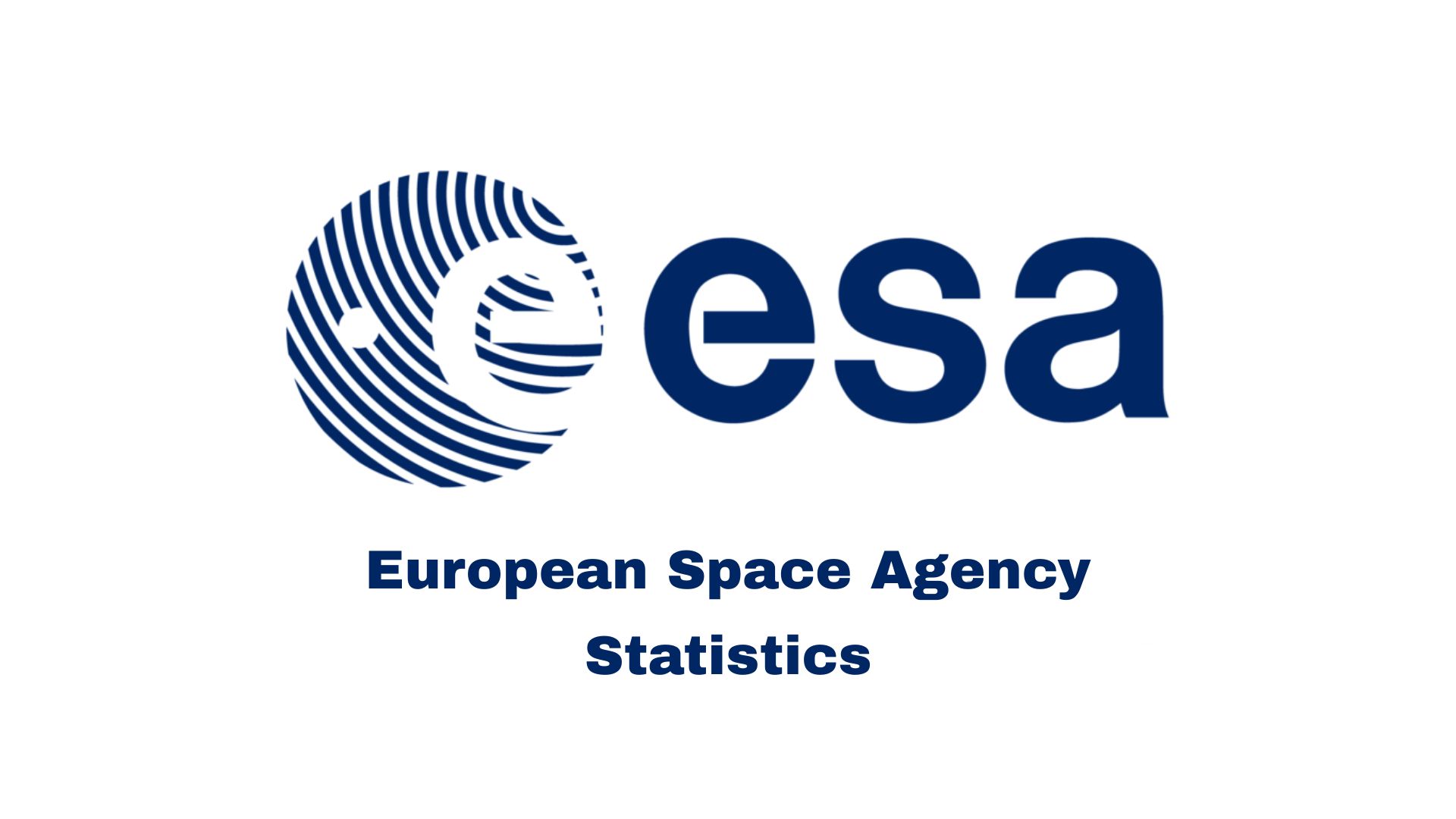
WHAT WE HAVE ON THIS PAGE
- Introduction
- Editor’s Choice
- What Does The European Space Agency Do?
- Who Belongs To The European Space Agency?
- Locations of the European Space Agency
- European Space Agency Budget And Expenditure Done On ESA?
- Largest Contribution To The European Space Agency’s Budget
- European Space Agency Facts And Figures 2022
- European Astronaut Program
- Recent Selections And Notable Achievements
- Space Environmental Report By the European Space Agency Statistics
- Orbital Regime Definitions
- A New B2B IAM Solution Statistics
- List Of European Space Agency Programs And Missions
- Eurospace Facts And Figures
- Guiana Space Centre Statistics
- Why Kourou is Ideal for Space Launches
- Satcen And European Space Agency
- Conclusion
Introduction
European Space Agency Statistics: The European Space Agency (ESA) is an intergovernmental organization dedicated to space exploration, headquartered in Paris, France. Established in 1975, ESA comprises 23 member states, including Austria, Belgium, the Czech Republic, Denmark, Estonia, Finland, France, Germany, Greece, Hungary, Ireland, Italy, Luxembourg, the Netherlands, Norway, Poland, Portugal, Romania, Slovenia, Spain, Sweden, Switzerland, and the United Kingdom. Canada participates in some projects under a cooperation agreement.
As of April 2025, ESA employs approximately 6,400 staff members across six continents. The agency’s budget for 2025 is USD 7.91 billion, reflecting a slight decrease from the USD 8.5 billion allocated in 2024. ESA’s funding supports a wide range of programs, including Earth observation, human spaceflight, and satellite navigation.
Let’s take a closer look at some statistics related to the European Space Agency.
Editor’s Choice
- The European Space Agency wished to improve the level of service for external users, strengthen the federation’s capacities, and reduce the administrative burden on internal staff regarding user management.
- In the recent crisis in Sudan, SatCen played a vital role in organizing the evacuation of European citizens from Khartoum, demonstrating its ability to handle emergency responses effectively.
- The European Space Agency budget will grow this year by 10% to almost $8.5 billion, the agency details at the yearly press briefing.
- The Guiana Space Centre, also known as Europe’s Spaceport, is situated northwest of Kourou in French Guiana, a French-speaking area in South America.
- The joint Work Plan is accepted at a yearly meeting at the Director’s level. The goal is to show the user requirements and the assured availability of the satellite data, techniques, and services, and correlate them with the events and projects.
- The Guiana Space Centre’s prime location near the equator, combined with its favorable climate, low population density, and robust infrastructure, makes it an ideal site for launching space missions.
What Does The European Space Agency Do?
Briefly, the European Space Agency’s job is to formulate and accomplish the European space program. The European Space Agency’s tasks are to find out more about Earth, it is the immediate space atmosphere, our Solar System, and the Universe, as well as to develop satellite-based techniques and services and to develop the European market. The European Space Agency also concentrates on space companies outside Europe.
Who Belongs To The European Space Agency?
Lithuania, Latvia, Slovenia, and Slovakia are Associate Members. Canada participates in some programs under a collaboration agreement. Bulgaria, Cyprus, Croatia, and Malta have collaboration agreements with the European Space Agency.
United Kingdom, Switzerland, Sweden, Spain, Romania, Portugal, Poland, Norway, the Netherlands, Luxembourg, Italy, Ireland, Hungary, Greece, Germany, France, Finland, Estonia, Denmark, the Czech Republic, Belgium, and Austria.
Locations of the European Space Agency
| ESEC | The European Space Security and Education Centre, Redu, Belgium |
| ECSAT | The European Center for Space Applications and Telecommunication, United Kingdom, Oxfordshire, Harwell. |
| ESTEC | The European Research and Technology Center, Noordwijk, the Netherlands. |
| ERIN | The European Space Agency Centre for Earth Observation is in Frascati, near Rome, Italy. |
| ESOC | The European Space Operations Centre in Darmstadt, Germany. |
| ESAC | The European Space Astronomy Centre is in Villanueva de la Canada, Spain, and Madrid. |
| EAC | The European Astronauts Centre in Cologne, Germany |
| ESA | The European Space Agency’s headquarters are in Paris, where the programs and policies are planned. ESA even has sites in different European nations, each with different responsibilities. |
| ESA | The European Space Agency even has liaison outlets in the United States of America, Belgium, and Russia, a launch base in French Guiana, and tracking stations in different parts of the globe. |
European Space Agency Budget And Expenditure Done On ESA?
- According to European Space Agency statistics, the agency’s budget for 2023 is almost €7.08 billion.
- The European Space Agency works based on geographical earnings, which means it makes investments in every Member State, from the industrial contracts for the European space programs, in an amount less than, equal to, or greater than every nation’s contribution.
- According to the European Space Agency, there is very little per capita speculation in space in Europe.
- In the median, each citizen of a European Space Agency member state pays taxes on space expenses similar to the cost of a cinema ticket.
Largest Contribution To The European Space Agency’s Budget
- In 2022, France will invest almost 1.1 billion euros in the European Space Agency to support the programs of European Space Agency’s research and development programs. At the time, Italy was the third biggest contributor, with around 680.2 million euros.
- Germany is estimated to invest almost 1,017.5 million euros, while Italy 680.2 million euros, the United Kingdom 437.9 million euros, Belgium with 238.7 million euros, Spain 220.7 million euros, Switzerland 174.7 million euros, the Netherlands 99.6 million euros, Sweden with 75 million euros, Norway with 71.8 million euros, Austria 49.8 million euros, Luxembourg with 47.5 million euros, Czechia with 45.4 million euros, Poland with 44.8 million euros, Romania with 39.4 million euros, Denmark with 33.8 million euros, Finland 28.7 million euros, Portugal 25.2 million euros, Ireland 22.9 million euros, Hungary with 21.2 million euros, Greece with 20 million euros, Canada with 16.9 million euros, Lithuania with 3 million euros, Slovenia with 2.7 million euros, Estonia with 2 million euros, Latvia with 1.1 million euros.
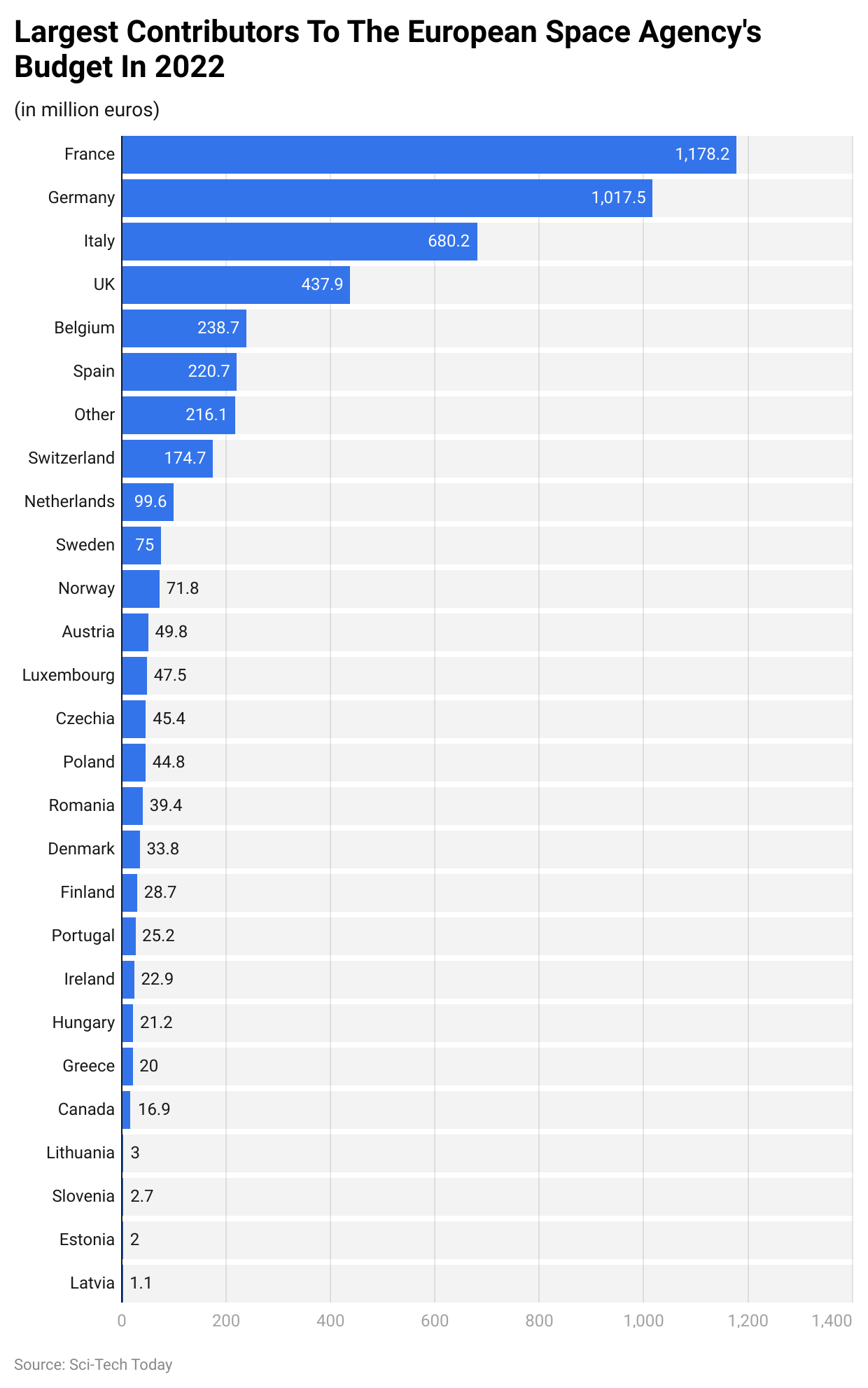 (Reference: statista.com)
(Reference: statista.com)
- In the chart below, we can see the budget of the European Space Agency between 2015 and 2022, which is a billion euros.
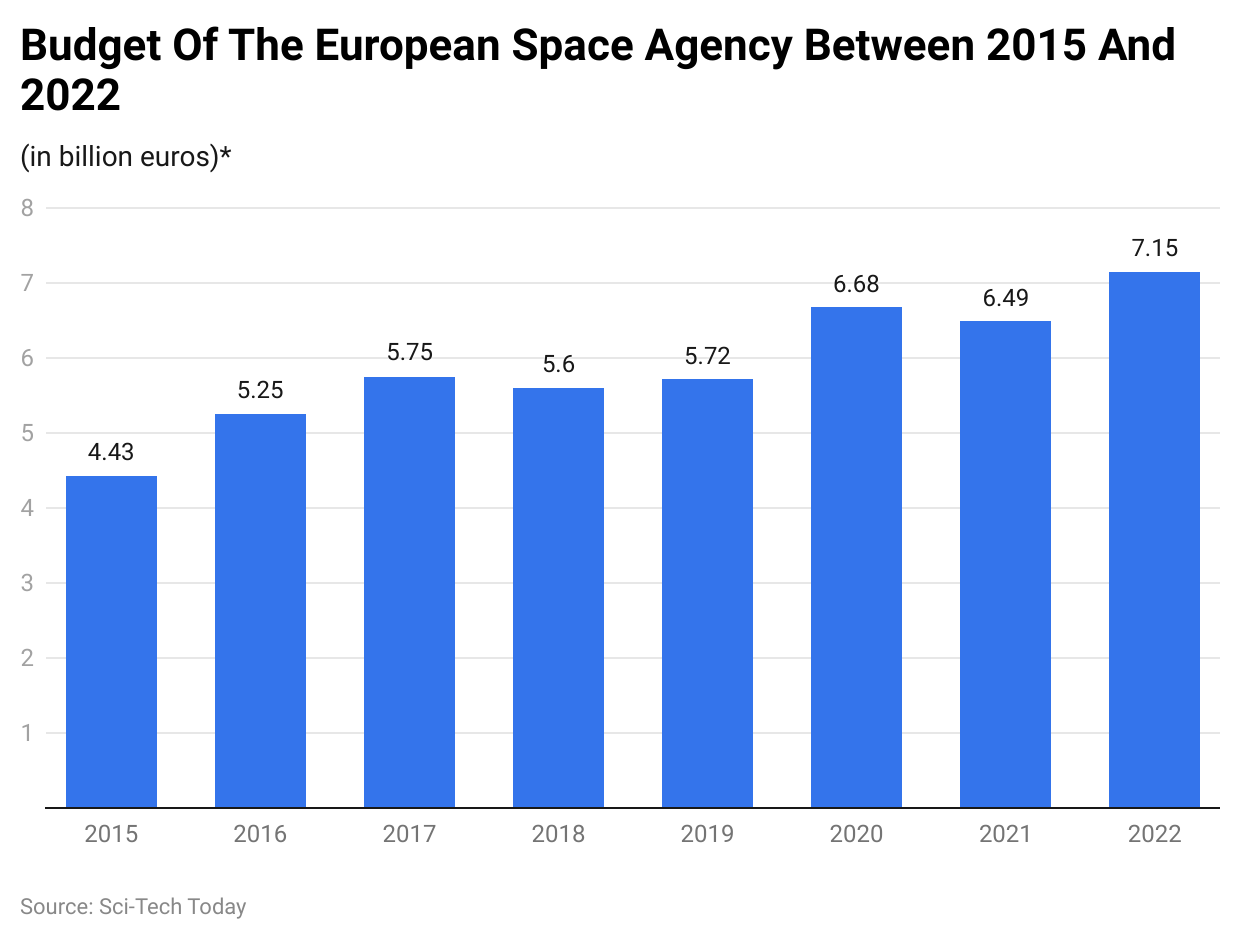 (Reference: statista.com)
(Reference: statista.com)
- In 2022, the European Space Agency’s budget was nearly 7.15 billion euros to execute its multiple operations for space innovations. Over the past years, the budget has grown somewhat continuously from 4.43 billion euros in 2015.
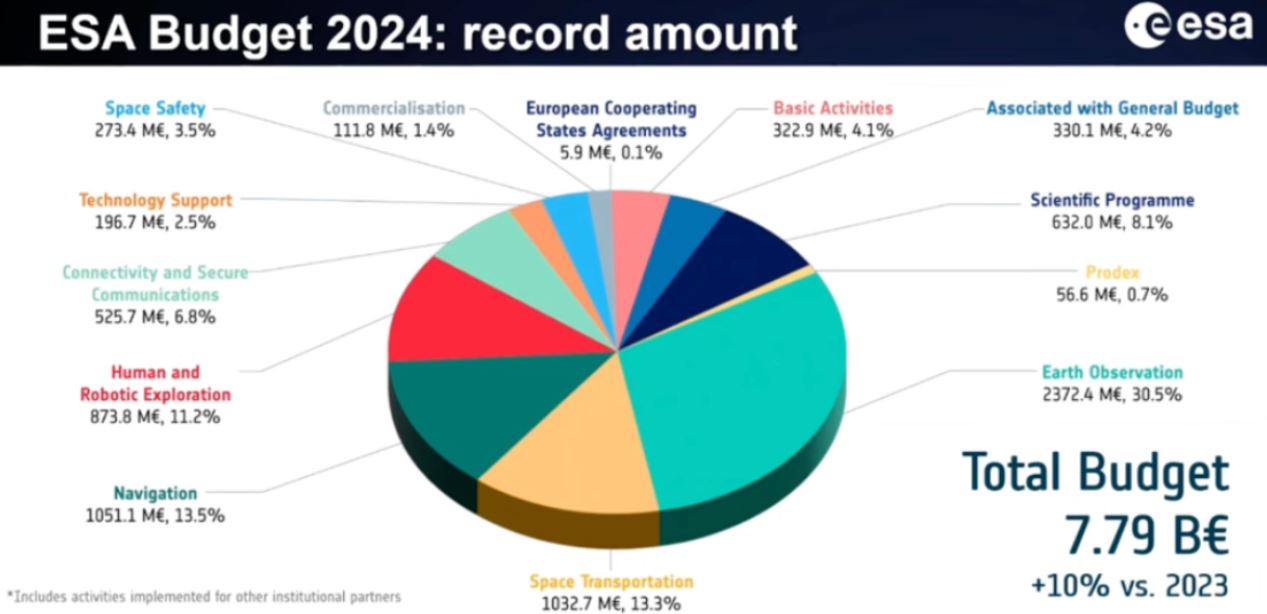 (Source: payloadspace.com)
(Source: payloadspace.com)
- In the above chart, we can see the European Space Agency Budget record for 2024.
- The European Space Agency budget will grow this year by 10% to almost $8.5 billion, the agency details at the yearly press briefing.
- The biggest fund buckets are 30.5% EO, 13.5% navigation, and 13.3% space transportation. The European Space Agency has planned five imaging satellites for 2024, including 2 Copernicus EO satellites.
- The 2024 budget has been funded by 64.5% of the European Space Agency, 23.4% of the EU, 10.5% of third-party agreement income, and 1.5% of Eumetsat.
- In dividing deep, the top countries contribute $1.3 billion: Germany, $1.15 billion; France, $965 million; Italy, $492 million United Kingdom.
- Europe’s space funding is still just a portion of the United States dollar heading to NASA, which will get almost $25.4 billion in 2023. Whereas the European Space Agency had secured a two-digit bump, NASA’s budget fund is estimated to stay flat or even decrease.
European Space Agency Facts And Figures 2022
- The trade association of the European Space Agency, namely Eurospace, had declared the launch of the 27th edition of its yearly report on the state of the European space manufacturing market in 2022.
- Eurospace has published the results of its yearly survey from 1996, covering around 500 entities in the European space manufacturing and introduction market. The report shows ascending consistency and a comprehensive series.
- The report shows that the European growth industry’s sales were 8.2 billion euros in 2022, a decrease of 400 million Euros from 2021.
- On the upstream of the European employment side, the increase remained in 2022, reaching a new record of almost 57,000 full-time equivalents. Hires in the small, medium, and large players drive employment growth.
- The press release outlines a wide range of economic shows that are significantly related to the worldwide context, the release service industry, and the captive and open markets. It details the employment and sales numbers for the European space growth market around its four essential macro-segments: launcher systems, scientific systems, satellite applications systems, and others.
European Astronaut Program
- Overview of ESA’s Astronaut Program and Achievements – NASA’s partnership with the European Space Agency (ESA) through the Spacelab program opened new avenues for European space exploration. This collaboration led to NASA inviting ESA to submit astronaut applications.
- Early Selections and Milestones – In 1978, ESA selected its first three astronauts. German astronaut Ulf Merbold was the first to travel to space, flying on the STS-9 mission in 1983, which was also Spacelab’s maiden flight.
- Expansion in the 1980s – As space missions became more frequent during the 1980s, several ESA member countries started their astronaut selection processes. These selected astronauts participated in both American space shuttle missions and Russian Soyuz missions, including trips to the Mir space station.
- Establishment of the European Astronaut Centre – In 1990, ESA established the European Astronaut Centre to prepare for its role in the International Space Station (ISS) program. In 1992, ESA conducted a new astronaut selection process, narrowing down over 22,000 applications to select six astronauts.
- Formation of a Unified European Astronaut Corps – In 1998, ESA consolidated its astronauts and those selected by individual European countries into a single large corps. By this time, European astronauts were taking on more specialized roles on the space shuttle, including spacewalks and other critical activities.
Recent Selections And Notable Achievements
The most recent selection of ESA astronauts concluded in 2009. Some key accomplishments include:
- Claude Nicollier’s Spacewalk (1999): The first European to perform a spacewalk using a U.S. spacesuit, working on the Hubble Space Telescope during the STS-103 mission.
- Thomas Reiter’s ISS Mission (2006): The first European to join an ISS crew, marking a significant milestone in European participation in space station missions.
The collaboration with NASA and the establishment of ESA’s astronaut programs have significantly enhanced Europe’s role in space exploration. From early selections to recent achievements, European astronauts have made vital contributions to international space missions.
Space Environmental Report By the European Space Agency Statistics
The latest Space Debris Environment Report that as reported by the European Space Agency’s Space Debris Office, is given below. This report was the seventh edition and was released on 12/06/2023. Following are the Space debris by the numbers:
| Questions | Answers |
| The number of debris objects predicted based on the statistical models to be in orbit as per (MASTER-8, Future People 2021) |
|
|
Total Mass of all the space objects in Earth’s orbit |
More than 11500 tonnes. |
|
Predicted the number of explosions, collisions, break-ups, or strange events that resulted in maintenance in their catalog. |
More than 640 |
| The number of debris objects generally tracked by Space Surveillance Networks and maintained in their catalog |
About 35150 |
|
Several debris are still functioning. |
About 9000 |
| Number of debris still in space |
About 11500 |
|
The number of satellites these rocket launches have placed in orbit around Earth |
About 16990 |
| The number of rockets launched from the start of the space age in 1957 |
Almost 6500 (eliminating the failures) |
- The environment is stated to contain all man-made objects, including fragments and elements that presently or previously did, reside in earth-bound orbit.
- Among that, space debris is defined as all the man-made objects that include elements and fragments in Earth’s orbit or entering the environment again that are not functional.
Orbital Regime Definitions
| Orbit Regime | Description | Limits |
| ESO | Escape Orbits | – |
| UFO | Undefined Orbit | – |
| LMO | LEO-MEO Crossing Orbits | hp < 2000 km, 2000 km < ha < 31570 km |
| HEO | Highly Eccentric Earth Orbit | hp < 31570 km, ha > 40002 km |
| MGO | MEO-GEO Crossing Orbit | 2000 km < hp < 31570 km, 31570 km < ha < 40002 km |
| HAO | High Altitude Earth Orbit | hp > 40002 km, ha > 40002 km |
| LEO | Low Earth Orbit | hp < 2000 km, ha < 2000 km |
| GHO | GEO-superGEO Crossing Orbits | 31570 km < hp < 40002 km, ha > 40002 km |
| MEO | Medium Earth Orbit | 2000 km < hp < 31570 km, 2000 km < ha < 31570 km |
| GTO | GEO Transfer Orbit | i < 90°, hp < 2000 km, 31570 km < ha < 40002 km |
| NSO | Navigation Satellites Orbit | 50° < i < 70°, 18100 km < hp < 24300 km, 18100 km < ha < 24300 km |
| EGO | Extended Geostationary Orbit | 37948 km < a < 46380 km, e < 0.25, i < 25° |
| IGO | Inclined Geosynchronous Orbit | 37948 km < a < 46380 km, e < 0.25, 25° < i < 180° |
| GEO | Geostationary Orbit | i < 25°, 35586 km < hp < 35986 km, 35586 km < ha < 35986 km |
A New B2B IAM Solution Statistics
- Because of the development of its Earth observation programs, the European Space Agency’s request identified a solution that could no longer fulfill its needs.
- The European Space Agency wished to improve the level of service for external users, strengthen the federation’s capacities, and reduce the administrative burden on internal staff regarding user management.
- The European Space Agency has started to look for a cloud-based identity solution that would meet its business identity needs. That result shall also be able to unite into their current premises, identify Governance and Administration-related solutions for access certification and provisioning.
List Of European Space Agency Programs And Missions
| Name | Year | Mission |
| Cornerstone 1- SOHO | December 1995 | It was a joint European Space Agency and NASA solar observation program that provided real-time data for the space weather forecast. |
| Cornerstone 2 XMM-Newton | December 1999(in operation) | An X-ray space telescope was launched to study the full range of cosmic X-ray sources. |
| Cornerstone 3 Rosetta | March 2004(completed) | 67P/Churyumov-Gerasimenko orbiter mission, which researched comets and their evolution. |
| Cornerstone 4 Herschel | May 2009(completed) | An infrared space mission for regular astronomy. |
| Medium 1 Huygens | October 1997 (completed) | Titan lander element of the Cassini-Huygens mission. That first landed in the outer solar system. |
| Medium 2 INTEGRAL | October 2002(in operation) | Gamma-ray space observatories are also capable of observing X-rays and visible light. |
| Medium 3 Planck | May 2009 (completed) | It was a Cosmology mission that had mapped the cosmic microwave background. |
| Mission 1 Gaia | December 2013 (in operation) | An astrometry mission that measured the place and the distance of almost one billion things in the Milky Way. |
| Mission 2 LISA Pathfinder | December 2015 (completed) | Technical demonstration for the Cosmic Vision LISA Gravitational wave mission. |
| Mission 3 BepiColombo | October 2018 | Joint ESA-JAXA survey mission to Mercury, even using two different spacecraft operations. |
| S1 – CHEOPS | December 2019 (in operation) | A space telescope mission that concentrated on exoplanet studies. |
| S2- SMILE | Launching 2025( in future) | Joint European Space Agency- CAS Earth observation mission to study the interaction between the solar wind and the planet’s magnetosphere. |
| M 1 Solar Orbiter | February 2020 (in operation) | This mission was planned to make an in situ study of the Sun. |
| M 4 ARIEL | Launching 2029 (in the future) | Planck-related space mission to study the environment of exoplanets. |
| M 5 EnVision | Launching 2031 ( in the future) | It was a mission to map Venus’ orbit. |
| L 1 JUICE | April 2023( in operation) | It is a Jupiter orbit mission. |
| L3 LISA | Launching 2035 ( in the future) | The first declared gravitation wave space mission. |
Eurospace Facts And Figures
- In 2022, the European Space Agency successfully delivered almost 96 spacecraft to the launch pad, of which around 13 were big satellites, and 83 were small satellites.
- The European Space Agency had also launched almost five launchers for the operation in Kourou.
| Key figures: employment (FTW) and sales | 2020 | 2021 | 2022 | Var. |
| Direct industry employment(FTE) | 50554 | 53146 | 57510 | 8,2% |
| Other personnel working on sites (FTE) | 2402 | 2422 | 2197 | -9,3% |
| Total space industry employment (FTE) | 52956 | 55568 | 59707 | 7,4% |
| Final sales in euros | 7725 | 8606 | 8257 | -4,1% |
- In the above table, direct industry employment refers to the people hired directly by the organization. They are the permanent staff and are measured in FTE.
- Also, in the above table, the other personnel working on-site are the people directly supporting the organization’s actions, supplied by the third party. That can include Engineers and interim employees.
- Final sales include the sales to the final customer.
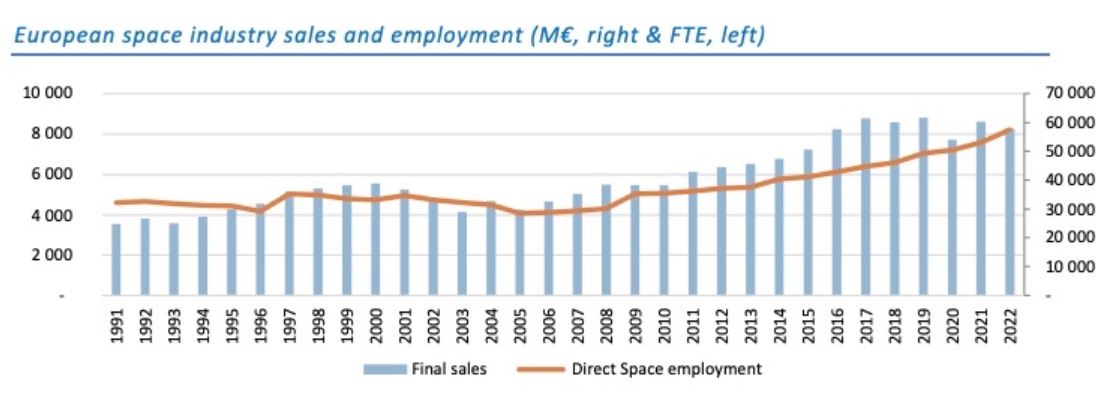
- In the above chart, we can see the European space industry’s sales and employment statistics.
- The European Space Agency is widespread and very large, but it is still divided domestically in its core market.
- The company is predicted to export its system outside Europe. In both markets, space systems are sold to various customers, most of the time, public entities like the space agencies in Europe and globally.
Final sales by the main customer section:
| M Euro | 2020 | 2021 | 2022 | Var. |
| Final Sales (M Euro) | 7725 | 8606 | 8257 | -4,1% |
| European public customers | 4900 | 5555 | 5556 | 0,0% |
| European private customers | 1299 | 1334 | 1073 | -19,5% |
| Other/unknown European customers | 99 | 117 | 104 | -10,9% |
| Public customers RoW | 458 | 459 | 363 | -20,9% |
| Private customers RoW | 942 | 1087 | 1132 | 4,1% |
| Other/Unknown customers RoW | 25 | 54 | 28 | -47,6% |
Final sales by main product segment (M EURO)
| M Euro | 2020 | 2021 | 2022 | Var. |
| Final sales | 7725 | 8606 | 8257 | -4,1% |
| Launcher Systems | 1316 | 1303 | 1214 | -6,8% |
| Satellite applications system | 3529 | 3974 | 3657 | -8,0% |
| Scientific systems | 1130 | 1347 | 1403 | 4,2% |
| Ground system and services | 1567 | 1806 | 1750 | -3,1% |
| Other & Unknown | 184 | 175 | 232 | 32,3% |
Guiana Space Centre Statistics
- The Guiana Space Centre, also known as Europe’s Spaceport, is situated northwest of Kourou in French Guiana, a French-speaking area in South America.
- Guiana Space Centre has been in operation since 1968, and its ability to reach the equator makes it an effective site for the launch of spacecraft in the near-equatorial and geostationary orbits.
- This location gives notable energy savings and safety benefits, as rockets can launch to the east over the open sea, therefore minimizing the risk.
- The European Space Agency, Arianespace, and CNES operate it. This center supports rockets involving Soyuz, Vega, and Ariana and has arrangements for payload integration and launch preparation.
- It is the basic site for the European satellite projects, which launch satellites for various purposes, including Earth observation, science research, and telecommunication.
Why Kourou is Ideal for Space Launches
- Equatorial Advantage: Kourou is just 5 degrees 3 minutes north of the equator. This position is advantageous because the Earth’s rotation provides extra speed to rockets, saving fuel and reducing costs. Rockets can also carry heavier payloads.
- Low Population Density: French Guiana is sparsely populated, with about 90% of the area covered by forests. This reduces the risk to human life and property in case of a launch accident.
- Stable Climate and Geology: The region is not prone to earthquakes or hurricanes, ensuring safer and more predictable launch conditions.
- Good Infrastructure and Access: The area has good access to the Atlantic Ocean, which is essential for transporting large rocket components. Ports and airports are also nearby, facilitating logistics and transportation.
- Historical and Ongoing Support: Since 1962, the French space agency CNES has been looking for an equatorial launch site. Kourou was chosen in 1964 due to its location, infrastructure, and political stability. The spaceport has grown significantly since its first mission in 1968.
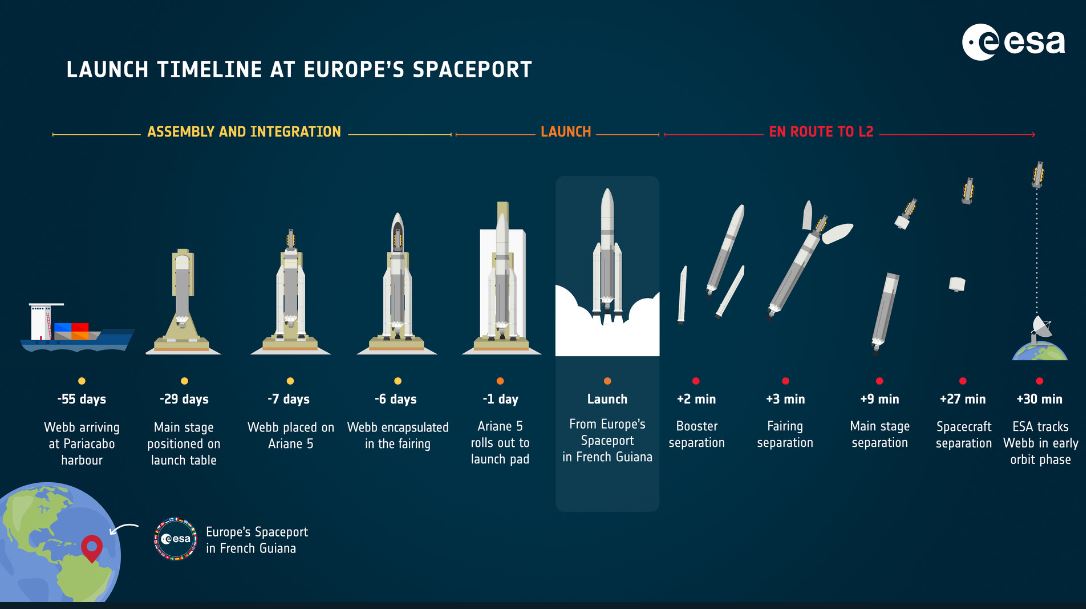
(Source: esa.int)
Notable Launches From Kourou
- Rosetta Mission (March 2, 2004): An Ariane rocket launched the Rosetta spacecraft, which travelled to Comet 67P/Churyumov–Gerasimenko. In 2014, Rosetta deployed the Philae lander, which, despite a bumpy landing, conducted significant research on the comet.
- Automated Transfer Vehicle (ATV) Missions (Starting March 9, 2008): The first ATV, named Jules Verne, was launched to supply the International Space Station (ISS). These vehicles delivered cargo and were used for experiments to improve future space missions.
- Herschel and Planck Space Telescopes (May 14, 2009): These telescopes were launched together on an Ariane 5 rocket. Herschel discovered molecular oxygen in space and studied comet water, while Planck mapped the cosmic microwave background radiation from the Big Bang.
- James Webb Space Telescope (Expected March 2021): This next-generation telescope, set to replace the Hubble Space Telescope, will focus on infrared astronomy. It aims to uncover the Universe’s origins and study exoplanet atmospheres.
Economic And Operational Benefits
- Cost Efficiency: Launching near the equator saves fuel, reducing overall mission costs. This allows for more frequent and diverse missions within the same budget.
- Increased Payload Capacity: The extra boost from Earth’s rotation allows rockets to carry more weight, making launches from Kourou more effective.
- Safety and Reliability: The stable climate and low risk of natural disasters ensure that launches can proceed as scheduled, minimizing costly delays.
- Strategic Location: The existing infrastructure, including ports and airports, supports the transportation of heavy and large rocket parts, enhancing operational efficiency.
- The Guiana Space Center’s prime location near the equator, combined with its favorable climate, low population density, and robust infrastructure, makes it an ideal site for launching space missions.
- The history of successful missions, including the Rosetta Comet mission and the upcoming James Webb Space Telescope, highlights its critical role in advancing space exploration.
- The economic benefits of fuel savings, increased payload capacity, and reliable launch conditions make Kourou a strategic and cost-effective choice for space agencies and commercial operators alike.
Satcen And European Space Agency
- The European Space Agency and SatCen have been connected for many years to strengthen the European capacity in the field of satellite EO for security-related applications. This relationship was formed in January 2018.
- The joint Work Plan is accepted at a yearly meeting at the Director’s level. Its goal is to show the user requirements and the assured availability of the satellite data, techniques, and services, and correlate it with the events and projects.
- SatCen, from its RTDI Unit, basically correlates with ESA TIA and the EOP directors in the Group of Earth Observation.
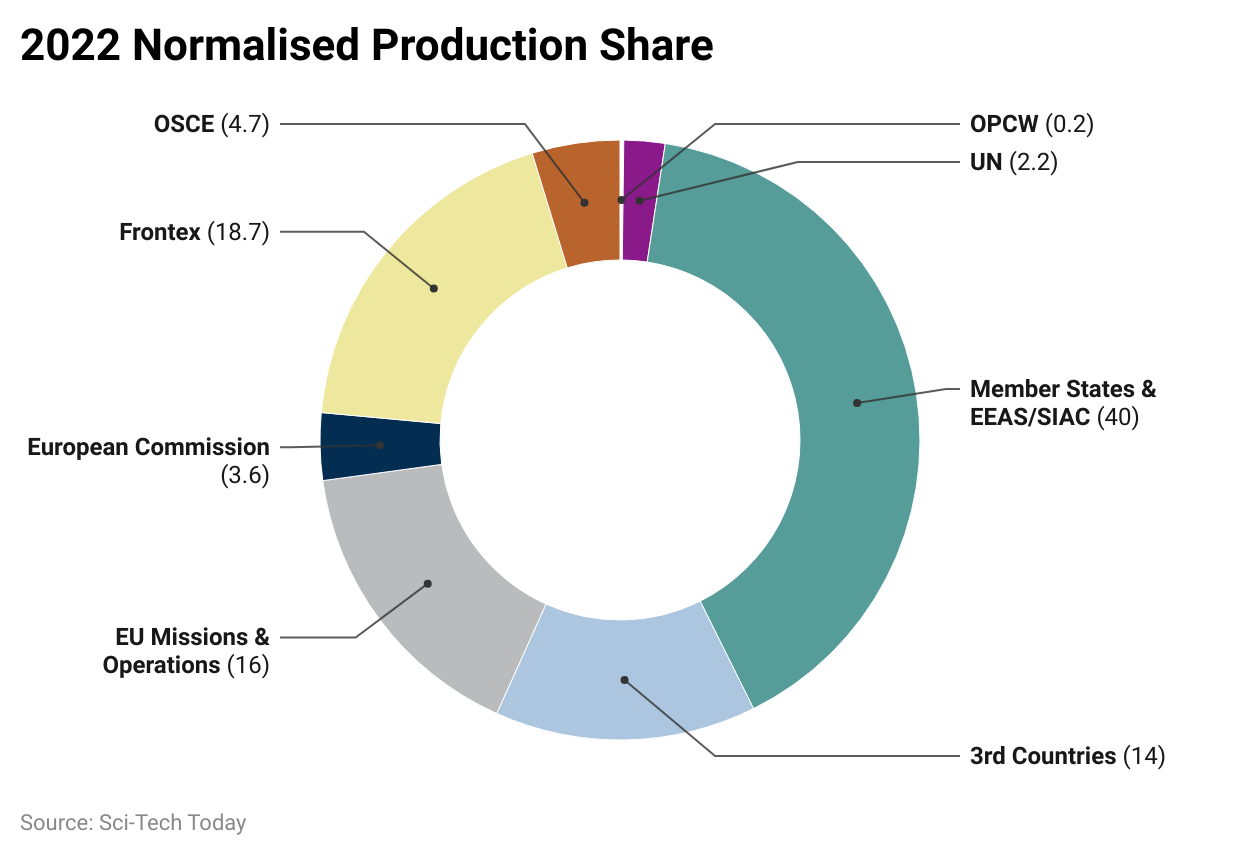 (Reference: eeas.europa.eu)
(Reference: eeas.europa.eu)
- In the above chart, we can see the Normalized production share in 2022 by SatCen.
| OPCW | 0.2% |
| OSCE | 4.7% |
| Frontex | 18.7% |
| European Commission | 3.6% |
| EU Mission & Operations | 16% |
| UN | 2.2% |
| Member States & EEAS/SIAC | 40% |
| 3rd Countries | 14% |
- The recent meeting with defense ministers occurred at a pivotal moment due to a substantial surge in demand for SatCen’s services, especially in the wake of the Russian aggression against Ukraine.
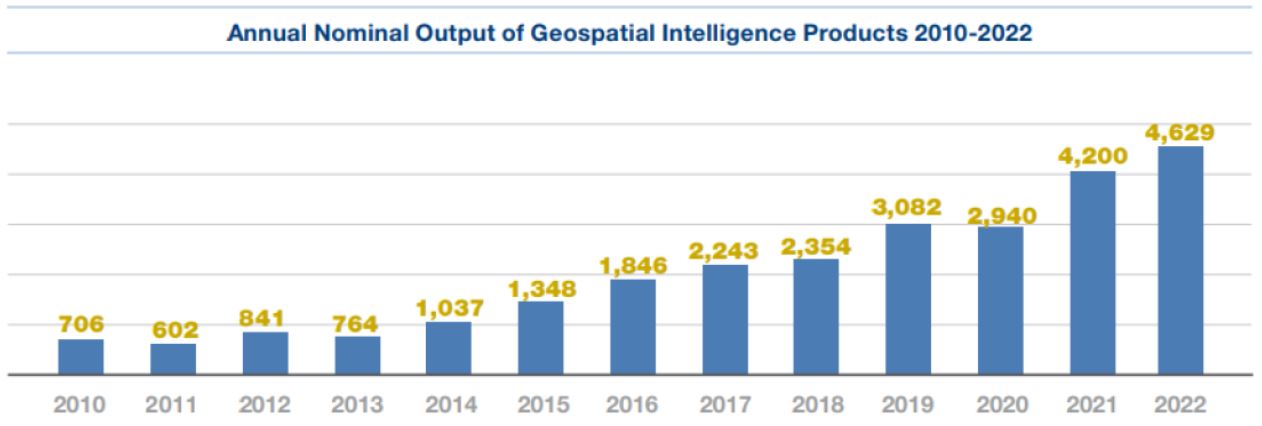
(Source: eeas.europa.eu)
- For perspective, since 2010, SatCen has experienced a tenfold increase in its production and output. This year alone, it has issued over 4,000 products, with more than 80% of them being delivered within 24 hours.
- We are dedicated to enhancing SatCen’s capabilities in line with the Strategic Compass.
- Earlier this year, as part of the implementation of the Compass, we introduced the first EU Space Strategy for Security and Defence.
- Within this framework, SatCen is expected to play a crucial role in the newly proposed EU Earth observation governmental service alongside the EU Space Programme Agency.
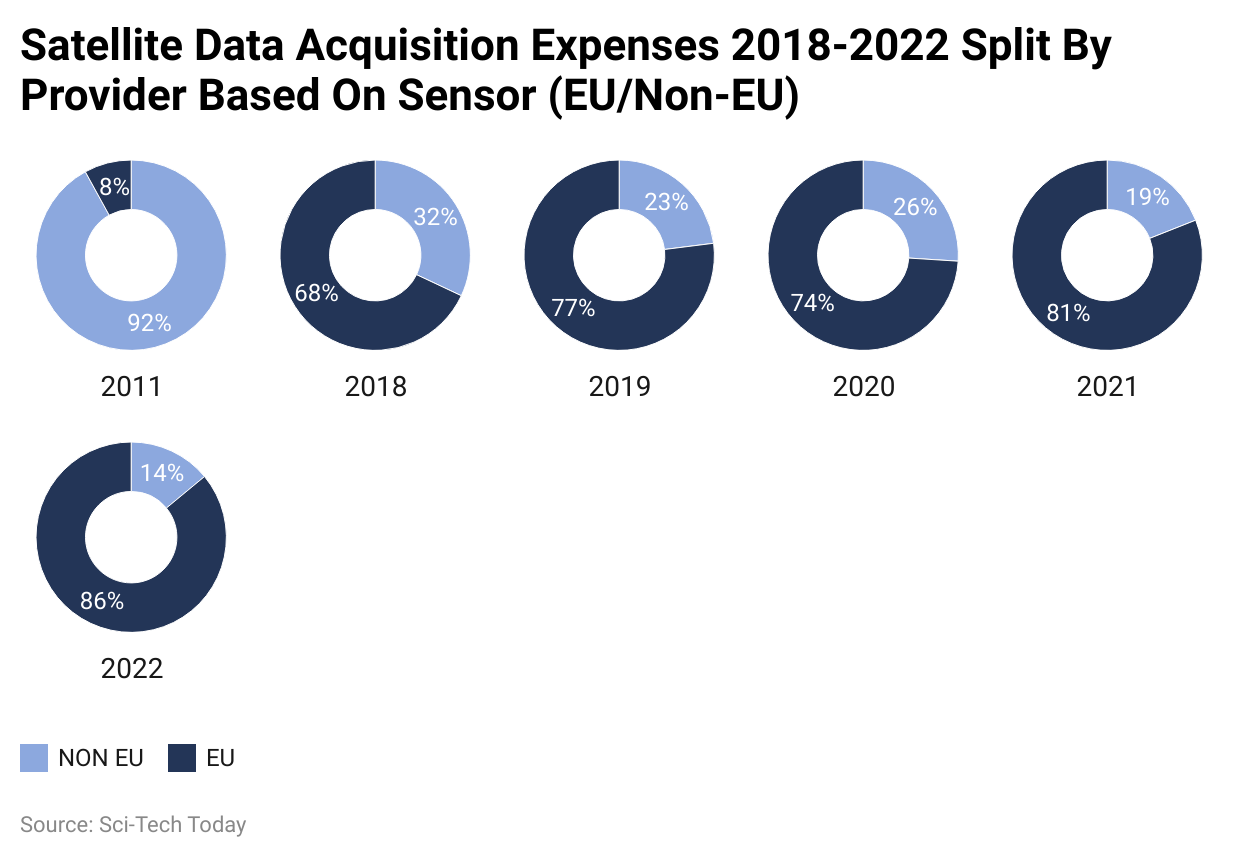 (Reference: eeas.europa.eu)
(Reference: eeas.europa.eu)
- The European Union Satellite Centre (SatCen) is essential for supporting EU operations globally, delivering prompt and reliable geospatial intelligence analysis. With over three decades of experience, SatCen exemplifies the EU’s strategic autonomy in this field.
- In the recent crisis in Sudan, SatCen played a vital role in organising the evacuation of European citizens from Khartoum, demonstrating its ability to handle emergency responses effectively.
- Additionally, SatCen collaborates with Frontex to assist in EU border management, such as at the Poland-Belarus border.
- Its contributions extend to various missions, including anti-piracy efforts, combating illegal arms trafficking, and providing humanitarian aid, such as during the 2020 Beirut port explosion.
- “With SatCen’s support, EU institutions and member states benefit from swift, high-quality, autonomous, and reliable analyses, enabling better-informed decision-making.”
- Leveraging commercial and governmental satellite data, SatCen operates in close synergy with the European space industry.
- This collaboration ensures that EU institutions and member states receive top-level geospatial intelligence, facilitating informed and effective decision-making.
Conclusion
The above article has illuminated the European Space Agency Statistics. By coordinating the intellectual and financial resources of its members, ESA can create programs and actions that are beyond the scope of any particular European nation. ESA closely collaborates with the European industry, national space agencies, and European unions and coordinates with the space industry globally.
Sources

Barry is a technology enthusiast with a passion for in-depth research on various technological topics. He meticulously gathers comprehensive statistics and facts to assist users. Barry's primary interest lies in understanding the intricacies of software and creating content that highlights its value. When not evaluating applications or programs, Barry enjoys experimenting with new healthy recipes, practicing yoga, meditating, or taking nature walks with his child.
